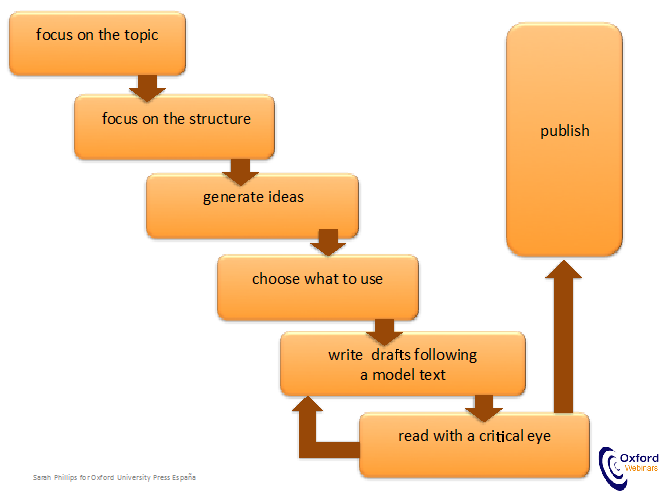Sarah Phillips, co-author of Incredible English second edition, looks at how you can help your students produce a good piece of writing step by step. She will be hosting a webinar on the same topic on 12th and 13th September. Find out more and register here.
It’s not easy to write a text. You need time, ideas, language, and editing skills.
Writing is a process
This flow diagram charts a set of possible steps from generating an idea to publishing a finished text.

In order for our pupils to become successful writers we have to work on each of the steps with them, supporting them and showing them different ways of approaching each one.
Focus on the topic and the structure of the text
Reading is an important precursor to writing a text. Exposing the children to different text types and encouraging them to notice their features helps them when they write their own texts.
Generate ideas and choose what to use
Ways of generating ideas include:
- completing a table with given headings
- adding headings to groups of words
- answering generic questions about sample texts and then using them as prompts for further ideas
- using a concept map as a way of organising words associated with key words
Once the pupils have put their ideas onto paper they can then select the ones they wish to include in their text. It is always better to have more ideas than you can use.
Model texts and first drafts
By giving the pupils model texts to work with, we are scaffolding their own writing. Such activities are an important step on the way to independent writing. The children can transfer information from tables, mind maps, notes and so on into a model text. This mimics the process they should follow when writing their own texts.
Once the children have worked on ways of generating ideas and done some activities with model texts, they can start to write their own texts following a clear set of instructions.
Reading with a critical eye
When they have a first draft it needs to be checked with a critical eye, which can be their own, their classmates’ or their teacher’s. It is important that they receive feedback on the content as well as the language. After all, the function of a piece of writing is to communicate with the reader. Give children a clear and simple set of criteria to look for when reading through their own or their peer’s work. When reading the children’s first drafts look for things that they will be able to correct themselves. You may want to correct the second draft more ruthlessly, especially if it is going to be published for a wider audience.
Publish
Writing is hard work, and it is a pity to spend a lot of time on writing a text only for it to disappear into a folder. Children’s work can be published in many different ways, for example: on the class noticeboard, on blogs and wikis, stapled together to make a class book for the reading corner or to take home to parents.
If you want more guidance and advice on how to help your students with writing a text in the Primary classroom, register for Sarah’s webinar on 12th or 13th September.


[…] "It’s not easy to write a text. You need time, ideas, language, and editing skills. Writing is a process. This flow diagram charts a set of possible steps from generating an idea to publishing a finished text." […]
[…] Sarah Phillips, co-author of Incredible English second edition, looks at how you can help your students produce a good piece of writing step by step. She will be hosting a webinar on the same topic… […]